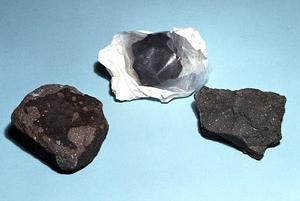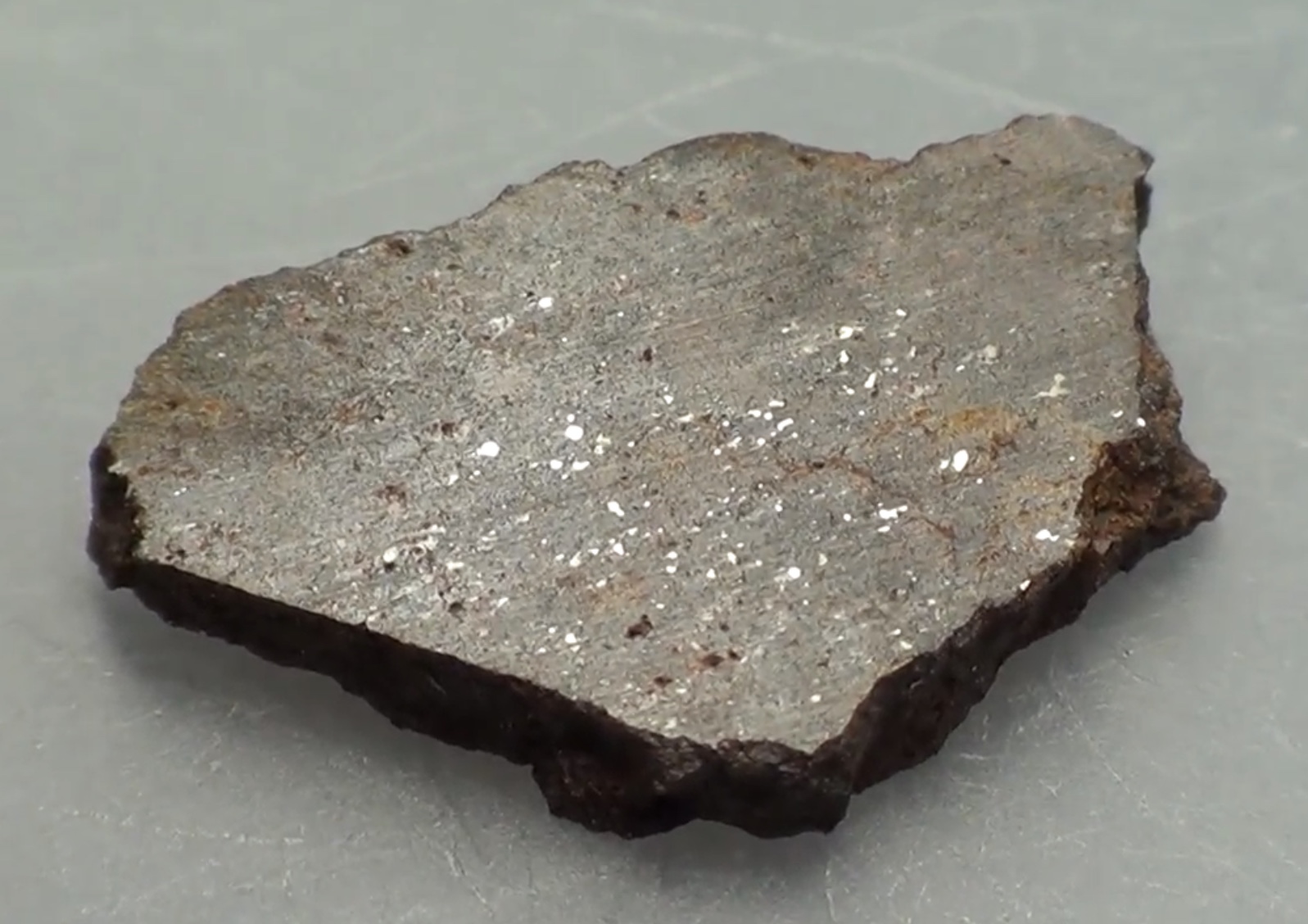|
Kaidun
Kaidun is a meteorite that fell on 3 December 1980 on a Soviet military base near what is now Al-Khuraybah in Yemen. A fireball was observed travelling from the northwest to the southeast, and a single stone weighing about was recovered from a small impact pit. It has been suggested that Kaidun originated from the Martian moon of Phobos, but this is disputed. Composition It contains a uniquely wide variety of minerals, causing debate about its origin. It is largely carbonaceous chondrite material of type CR2, but also contains fragments of other types, such as C1, CM1, and C3. Of the nearly 60 minerals found in the meteorite, several have not been found elsewhere in nature, such as florenskyite, which has the chemical formula Fe Ti P. Origin In March 2004 it was suggested that the meteorite originated from the Martian moon Phobos. The reason Phobos has been suggested is the existence of two extremely rare alkaline-rich clasts visible in the meteorite, each of which entere ... [...More Info...] [...Related Items...] OR: [Wikipedia] [Google] [Baidu] |
Phobos (moon)
Phobos (; systematic designation: ) is the innermost and larger of the two natural satellites of Mars, the other being Deimos. The two moons were discovered in 1877 by American astronomer Asaph Hall. It is named after Phobos, the Greek god of fear and panic, who is the son of Ares (Mars) and twin brother of Deimos. Phobos is a small, irregularly shaped object with a mean radius of . Phobos orbits from the Martian surface, closer to its primary body than any other known planetary moon. It is so close that it orbits Mars much faster than Mars rotates, and completes an orbit in just 7 hours and 39 minutes. As a result, from the surface of Mars it appears to rise in the west, move across the sky in 4 hours and 15 minutes or less, and set in the east, twice each Martian day. Phobos is one of the least reflective bodies in the Solar System, with an albedo of just 0.071. Surface temperatures range from about on the sunlit side to on the shadowed side. The defining surfa ... [...More Info...] [...Related Items...] OR: [Wikipedia] [Google] [Baidu] |
Meteorite
A meteorite is a solid piece of debris from an object, such as a comet, asteroid, or meteoroid, that originates in outer space and survives its passage through the atmosphere to reach the surface of a planet or moon. When the original object enters the atmosphere, various factors such as friction, pressure, and chemical interactions with the atmospheric gases cause it to heat up and radiate energy. It then becomes a meteor and forms a fireball, also known as a shooting star; astronomers call the brightest examples " bolides". Once it settles on the larger body's surface, the meteor becomes a meteorite. Meteorites vary greatly in size. For geologists, a bolide is a meteorite large enough to create an impact crater. Meteorites that are recovered after being observed as they transit the atmosphere and impact the Earth are called meteorite falls. All others are known as meteorite finds. Meteorites have traditionally been divided into three broad categories: stony meteorites that ... [...More Info...] [...Related Items...] OR: [Wikipedia] [Google] [Baidu] |
Carbonaceous Chondrite
Carbonaceous chondrites or C chondrites are a class of chondritic meteorites comprising at least 8 known groups and many ungrouped meteorites. They include some of the most primitive known meteorites. The C chondrites represent only a small proportion (4.6%) of meteorite falls. Some famous carbonaceous chondrites are: Allende, Murchison, Orgueil, Ivuna, Murray, Tagish Lake, Sutter's Mill and Winchcombe. General description C chondrites contain a high proportion of carbon (up to 3%), which is in the form of graphite, carbonates and organic compounds, including amino acids. In addition, they contain water and minerals that have been modified by the influence of water. The carbonaceous chondrites were not exposed to higher temperatures, so that they are hardly changed by thermal processes. Some carbonaceous chondrites, such as the Allende meteorite, contain calcium-aluminum-rich inclusions (CAIs). These are compounds that emerged early from the primeval solar nebula, c ... [...More Info...] [...Related Items...] OR: [Wikipedia] [Google] [Baidu] |
Chondrite
A chondrite is a stony (non- metallic) meteorite that has not been modified, by either melting or differentiation of the parent body. They are formed when various types of dust and small grains in the early Solar System accreted to form primitive asteroids. Some such bodies that are captured in the planet's gravity well become the most common type of meteorite by (whether quickly, or after many orbits) arriving on a trajectory toward the planet's surface. Estimates for their contribution to the total meteorite population vary between 85.7% and 86.2%. Their study provides important clues for understanding the origin and age of the Solar System, the synthesis of organic compounds, the origin of life and the presence of water on Earth. One of their characteristics is the presence of chondrules (from the Ancient Greek χόνδρος ''chondros'', grain), which are round grains formed as molten, or partially molten droplets, in the space by distinct minerals, that normally co ... [...More Info...] [...Related Items...] OR: [Wikipedia] [Google] [Baidu] |
New Scientist
''New Scientist'' is a magazine covering all aspects of science and technology. Based in London, it publishes weekly English-language editions in the United Kingdom, the United States and Australia. An editorially separate organisation publishes a monthly Dutch-language edition. First published on 22 November 1956, ''New Scientist'' has been available in online form since 1996. Sold in retail outlets (paper edition) and on subscription (paper and/or online), the magazine covers news, features, reviews and commentary on science, technology and their implications. ''New Scientist'' also publishes speculative articles, ranging from the technical to the philosophical. ''New Scientist'' was acquired by Daily Mail and General Trust (DMGT) in March 2021. History Ownership The magazine was founded in 1956 by Tom Margerison, Max Raison and Nicholas Harrison as ''The New Scientist'', with Issue 1 on 22 November 1956, priced at one shilling (a twentieth of a pound in pre-decimal UK ... [...More Info...] [...Related Items...] OR: [Wikipedia] [Google] [Baidu] |
1980 In Asia
__NOTOC__ Year 198 (CXCVIII) was a common year starting on Sunday (link will display the full calendar) of the Julian calendar. At the time, it was known as the Year of the Consulship of Sergius and Gallus (or, less frequently, year 951 ''Ab urbe condita''). The denomination 198 for this year has been used since the early medieval period, when the Anno Domini calendar era became the prevalent method in Europe for naming years. Events By place Roman Empire * January 28 ** Publius Septimius Geta, son of Septimius Severus, receives the title of Caesar. ** Caracalla, son of Septimius Severus, is given the title of Augustus. China *Winter – Battle of Xiapi: The allied armies led by Cao Cao and Liu Bei defeat Lü Bu; afterward Cao Cao has him executed. By topic Religion * Marcus I succeeds Olympianus as Patriarch of Constantinople (until 211). Births * Lu Kai (or Jingfeng), Chinese official and general (d. 269) * Quan Cong, Chinese general and ... [...More Info...] [...Related Items...] OR: [Wikipedia] [Google] [Baidu] |
Glossary Of Meteoritics
This is a glossary of terms used in meteoritics, the science of meteorites. # * 2 Pallas – an asteroid from the asteroid belt and one of the likely parent bodies of the CR meteorites. * 4 Vesta – second-largest asteroid in the asteroid belt and likely source of the HED meteorites. * 221 Eos – an asteroid from the asteroid belt and one of the likely parent bodies of the CO meteorites. * 289 Nenetta – an asteroid from the asteroid belt and one of the likely parent bodies of the angrites. * 3103 Eger – an asteroid from the asteroid belt and one of the likely parent bodies of the aubrites. * 3819 Robinson – an asteroid from the asteroid belt and one of the likely parent bodies of the angrites. * IA meteorite – an iron meteorite group now part of the IAB group/complex. * IAB meteorite – an iron meteorite and primitive achondrite of the IAB group/complex. * IB meteorite – an iron meteorite group now part of the IAB group/complex. * IC meteorite – ... [...More Info...] [...Related Items...] OR: [Wikipedia] [Google] [Baidu] |
Deimos (moon)
Deimos ( systematic designation: Mars II) is the smaller and outermost of the two natural satellites of Mars, the other being Phobos. Of similar composition to C and D-type asteroids, Deimos has a mean radius of and takes 30.3 hours to orbit Mars. Deimos is from Mars, much farther than Mars's other moon, Phobos. It is named after Deimos, the Ancient Greek god and personification of dread and terror. Discovery and etymology Deimos was discovered by Asaph Hall III at the United States Naval Observatory in Washington, D.C. on 12 August 1877, at about 07:48 UTC. Hall, who also discovered Phobos shortly afterwards, had been specifically searching for Martian moons at the time. The moon is named after Deimos, a figure representing dread in Greek mythology. The name was suggested by academic Henry Madan, who drew from Book XV of the ''Iliad'', where Ares (the Roman god Mars) summons Dread (Deimos) and Fear ( Phobos). Origin The origin of Mars's moons is unknow ... [...More Info...] [...Related Items...] OR: [Wikipedia] [Google] [Baidu] |
Igneous Differentiation
In geology, igneous differentiation, or magmatic differentiation, is an umbrella term for the various processes by which magmas undergo bulk chemical change during the partial melting process, cooling, emplacement, or eruption. The sequence of (usually increasingly silicic) magmas produced by igneous differentiation is known as a magma series. Definitions Primary melts When a rock melts to form a liquid, the liquid is known as a ''primary melt''. Primary melts have not undergone any differentiation and represent the starting composition of a magma. In nature, primary melts are rarely seen. Some leucosomes of migmatites are examples of primary melts. Primary melts derived from the mantle are especially important and are known as ''primitive melts'' or primitive magmas. By finding the primitive magma composition of a magma series, it is possible to model the composition of the rock from which a melt was formed, which is important because we have little direct evidence of the ... [...More Info...] [...Related Items...] OR: [Wikipedia] [Google] [Baidu] |
Parent Body
In meteoritics, a parent body is the celestial body from which originates a meteorite or a class of meteorites. Identification The easiest way to correlate a meteorite with a parent body is when the parent body still exists. This is the case for Lunar and Martian meteorites. Samples from Lunar meteorites can be compared with samples from the Apollo program. Martian meteorites can be compared to analysis carried out by rovers (e.g. Curiosity). Meteorites can also be compared to spectral classes of asteroids. In order to identify the parent body of a class of meteorites, scientists compare their albedo and spectra with other known bodies. These studies show that some meteorite classes are closely related to some asteroids. The HED meteorites for example are correlated with 4 Vesta.Gunter Faure, Teresa M. Mensing. ''Introduction to Planetary Science: The Geological Perspective''Page 175 Another, perhaps most useful way to classify meteorites by parent bodies is by grouping ... [...More Info...] [...Related Items...] OR: [Wikipedia] [Google] [Baidu] |




